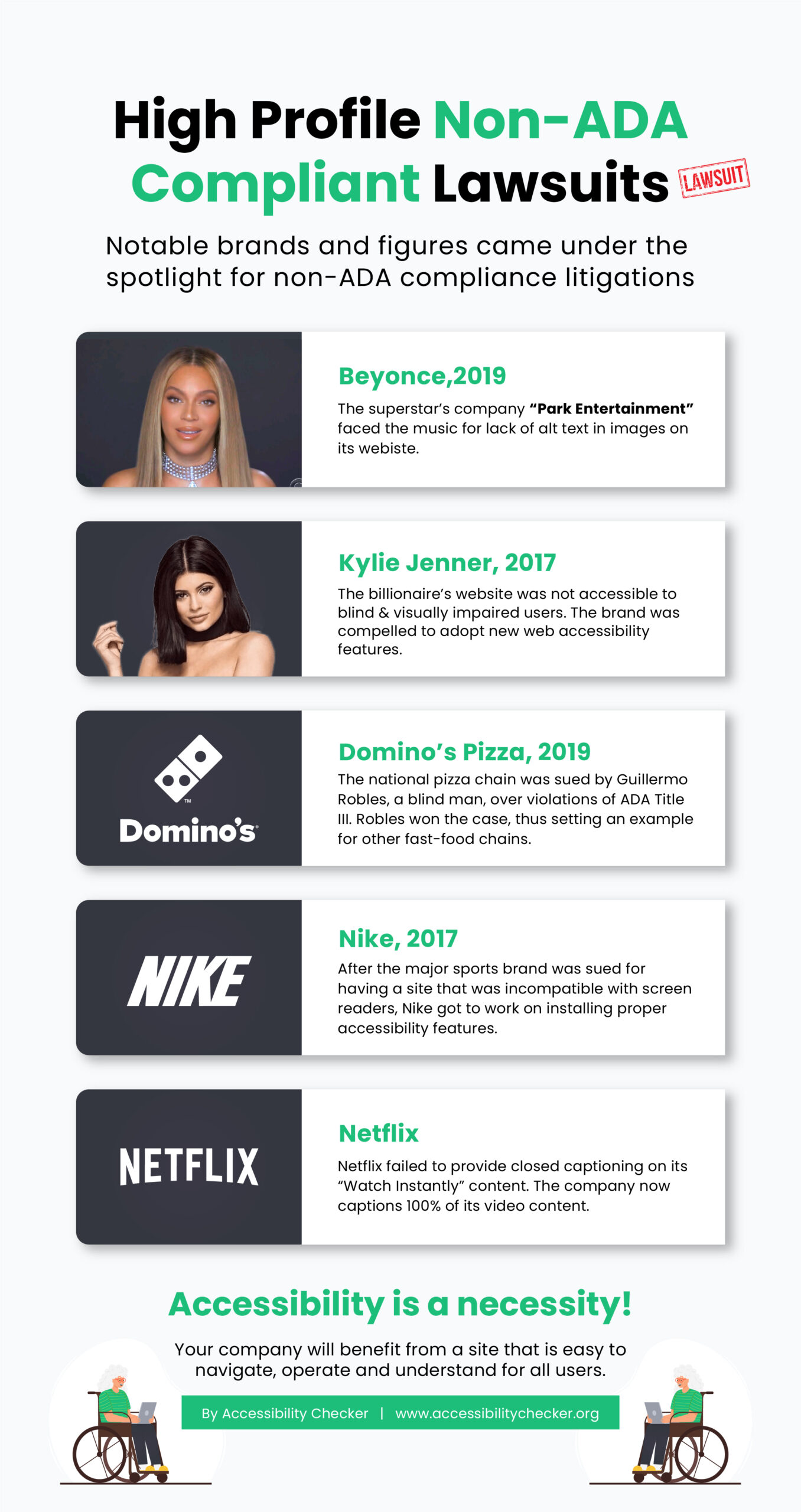accessiBe is one of the most talked-about web accessibility tools available today. It helps take a lot of the manual work out of adhering to ADA and WCAG guidelines by making it quicker and easier to identify web accessibility issues on your site.
You’ve heard about it but now it’s time to learn about it.
If you’re a business or website owner in Australia, it’s essential to be aware of DDA compliance requirements. Not only will this allow you to provide a more inclusive online experience, but you can also protect your brand against legal action.
If you’ve ever wanted to learn more about website accessibility in Australia, this is the guide for you.
Let’s begin.
Web accessibility issues are affecting a number of industries and businesses of all sizes across Australia.
But what exactly is the connection between the Disability Discrimination Act 1992 (DDA) and websites?

Let’s start with the fact that 1 in 5 Australians are living with some form of disability – that’s over 2 million Australians of working age alone. This is according to the Australian Network on Disability (1).
Another study conducted by the Centre of Inclusive Design (2) has found that close to 5 million Australians don’t have access to certain products and services because of poor design.
This means if you own a website that’s not DDA compliant, you’re losing out on billions-worth of potential revenue every year. Not to mention the legal ramifications of non-compliance.
The Disability Discrimination Act 1992 (DDA) (3) was created to protect people with disabilities from discrimination. This protection applies across areas of work, accommodation, leisure, education, as well as goods and services.
The act states that persons with disabilities are entitled to the same equality and fundamental rights as persons without disabilities. It also promotes the recognition and acceptance of these individuals within a community.
The DDA is based on WCAG, which is the benchmark of web accessibility, and was first used during the case of Bruce Lindsay Maguire v Sydney Organising Committee for the Olympic Games.
During the 1999 case, the Australian Human Rights and Equal Opportunity Commission ruled that Bruce Lindsay Maguire, who is blind, had been directly discriminated against by a government agency that didn’t provide ticketing materials in braille for the Sydney Olympic Games.

The DDA is made up of different divisions that cover the following:
Division 1: Discrimination in Work
Division 2: Discrimination in Other Areas
Division 3: Disability Standards
Division 4: Discrimination Involving Harassment
Division 5: Offences
Division 6: Exemptions
Division 2 covers goods, services, and facilities, which is where websites come into play.
However, web accessibility in Australia is made up of more than just the DDA. There are additional laws and standards in place depending on the type of service you offer.
Let’s get into those now.
The Australian Government’s Web Accessibility National Transition Strategy (NTS) states that all web properties need to meet WCAG 2.2 Level AA. (This applies to any type of website including government agencies and all organizations that serve the public, including private businesses).
WCAG, or Web Content Accessibility Guidelines, was originally developed in the U.S. with the goal of providing a single standard for web content accessibility. It’s also what the DDA was based on. The WCAG documents outline how to make websites more accessible to people with disabilities.
The Digital Service Standard (4) is for anyone designing and delivering Australian Government services. These include any services that are public facing, owned by non-corporate Commonwealth entities, informational and transactional services, and high-volume transactional services.
It is made up of 13 criteria that ensure digital professionals are able to create fast and simple online government services that are inclusive of all users, regardless of ability or environment.
We’re almost there – accessibility requirements for ICT products and services are the final set of standards that apply to web accessibility in Australia.

AS EN 301 549:2020 (5) outlines the minimum standards that ICT product and services provider websites need to meet. This includes hardware, software, and any other technologies that someone might interact with. These standards adopt the EN 301-549 European accessibility standards.
These standards apply to the public, private, and not-for-profit sectors.
In 2019-20, the Australian Commission of Human Rights (6) received 12,554 enquiries.
As with previous years, employment and the provision of goods, services and facilities were the main areas of complaint.
And 44% of those complaints were lodged under the Disability Discrimination Act
Any government or public-facing websites are required to comply with DDA web accessibility laws. This is applicable across all major industries, including:
✅ Banking and Finance
✅ Recreation
✅ Transport
✅ Education
✅ Employment
✅ Real estate
✅ Entertainment
✅ eCommerce
✅ Tourism
✅ Food and agriculture
In 2014, a visually impaired woman filed a complaint against the Coles supermarket chain because their online shopping service was not accessible to her. This claim eventually made it to the Federal Circuit Court with the claimant asking for millions of dollars.
The reality is, DDA lawsuits are impacting businesses of all sizes. Even brands such as Netflix and Amazon and stars such as Beyonce have had to fight web accessibility suits.

If your website is not fully accessible to everyone, regardless of ability, a complaint can be filed, and legal action can be taken against your business.
Anyone who feels they have been discriminated against can submit a complaint on the Australian Human Rights Commission website. An investigation is then launched and both parties will have the opportunity to discuss and resolve the issue.
If the person who filed the complaint is not satisfied with the outcome, they can take the case directly to the Federal Court of Australia.
The result is high settlement fees and a damaged reputation, all of which can be avoided by taking some simple steps to become DDA complaint.
Not only are these suits inconvenient and destructive to your brand, but if you don’t have access to a sizeable legal budget, a suit such as this can have far-reaching financial implications.
Overall, any online platform, including websites, apps, and online stores needs to cater to people of all abilities.
You could take the chance and leave your website as is, or you could avoid the headache and financial risks and become DDA compliant.

What’s more, you get to support the movement to make the web a more accessible place for all, while also benefitting from additional revenue streams.
Let’s discuss how you can achieve this.
The DDA was based on WCAG (Web Content Accessibility Guidelines). These are the guidelines you need to follow to become DDA compliant.
When you first open the 80+ page WCAG document, website accessibility seems a lot more complicated.
However, we’ve packaged it in a more digestible format so that you can make the necessary changes as quickly as possible.
As you make your website accessible, you will be focusing on elements such as:
Readability: How easy is your text to read and understand. Is your text structured in a way that makes it easy to scan?
Links: Have you implemented descriptive link text to give them more context?
Media: Do your images have alt text and have you added captions or transcripts to your video and audio files?
Colour: Does the color contrast ratio of your site cater to those with color blindness?
Basically, you want your website to be operable, perceivable, understandable, and robust across a wide range of assistive technology.
A Fast and Efficient Way to Comply with Web Accessibility Guidelines
Our top-recommended web accessibility solution is accessiBe. This advanced AI-powered tool makes it easier to apply the latest WCAG standards to your site by simply adding a line of code to the back-end.
To make your website accessible, you need to do two things:
1. Add a website accessibility interface
When your site has an accessibility interface, any visitor can adjust the design and user interface elements to suit their needs. Here are some of the ways this interface can help those with disabilities:
2. Compatibility with assistive technologies
Assistive technologies also make it easier for visitors with disabilities to navigate your site. Some of what you can implement includes:
Screen Readers
Screen readers are a must if you want to make your website accessible. They’re designed to help visually impaired users read the content on your site, including both text and images. This is why it’s essential for all images on your site to have alternative text.
Alternative text can describe an object or location to a user who cannot see the images. It also provides them with a better understanding of your site’s content by telling the full story.

Navigation tools
Assistive technologies such as navigation tools ensure your site also caters to users who don’t have full motor function.
Navigational tools that you can implement on your site include:
The good news is that there’s no longer any need to make manual updates to your site to be compliant. In fact, not only is it time-consuming, but costly too. This is because you would need a professional to audit your site and plan and implement the changes.
Automated tools are changing how easily a business can make its website more accessible to users with disabilities.
accessiBe is one of the most talked-about web accessibility tools available today. It helps take a lot of the manual work out of adhering to ADA and WCAG guidelines by making it quicker and easier to identify web accessibility issues on your site.




UserWay is trusted by thousands of leading brands that want to create a more inclusive experience for their online users. With the help of an easy-to-use accessibility overlay, it’s never been easier to ensure your Magento site is compliant with some of the top ADA requirements.




Confirm whether your website is at risk of web accessibility lawsuits and if you need to make changes to meet DDA standards.
Get started with your free audit now.
If your scan returns results that indicate website accessibility issues, you can take steps to rectify them before you’re forced to deal with the legal ramifications. Your report will show you exactly how to fix each problem.
Scan your website for accessibility related issues for free
A DDA is a Disability Discrimination Act. This type of activity ensures that anyone living with a disability has access to public spaces, including educational institutions, restaurants, websites, sporting venues, hospitals, libraries, and more.
DDA is an acronym for the Disability Discrimination Act, which is applicable in several countries, including Australia and the UK. The DDA applies to key areas of life and benefits those living with disabilities.
Website accessibility in Australia falls under the Disabilities Discrimination Act 1992. The act was created to ensure that those living with disabilities were able to access online products and services in the same way that everyone else could.
The easiest way to check web accessibility in Australia is to use an automated accessibility tool. These tools are designed to scan your site to check for accessibility issues. Many of the top tools provide you with instructions on how to fix any accessibility issues, while other tools will even carry out the fixes for you.